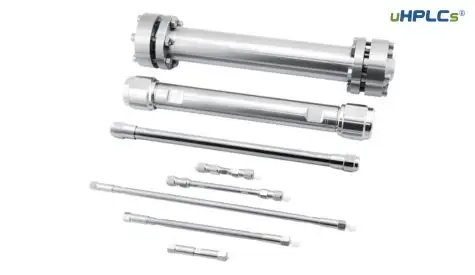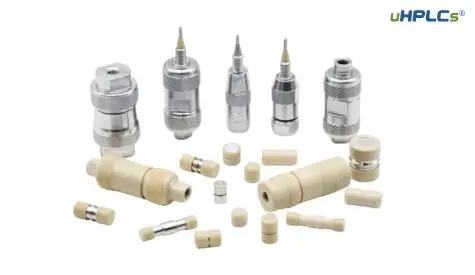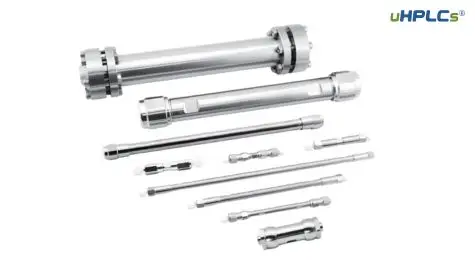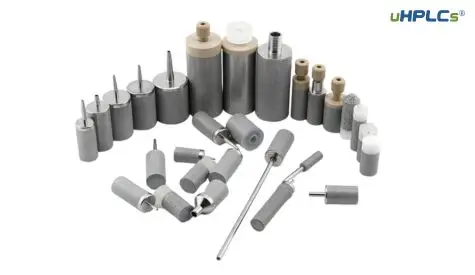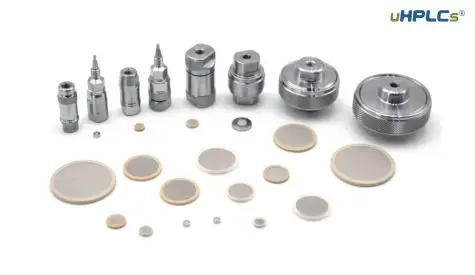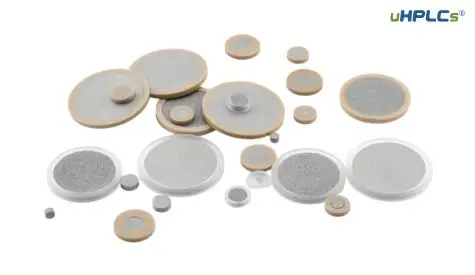How to Calculate Concentration from Peak Area in HPLC
High-Performance Liquid Chromatography (HPLC) is a powerful analytical technique used in various industries, including pharmaceuticals, food and beverage, and environmental analysis. HPLC aims to separate and identify individual components in a mixture and quantify their concentrations. The concentration of each component can be determined by measuring the peak area in the chromatogram. This information is essential for characterizing a sample and making informed decisions about the sample’s quality and safety. In this blog, we will discuss the theory behind calculating concentration from peak area in HPLC and provide a step-by-step guide to help you accurately determine the components’ concentration in your sample.
Theory Behind Calculating Concentration from Peak Area
In HPLC, components are separated by forcing a mixture through a column packed with a stationary phase, usually a silica gel or a polymer. The components in the mixture interact differently with the stationary phase and are separated based on their retention times. The retention time of a component is the amount of time it takes for the component to travel from the injection point to the detector. The detector in HPLC measures the quantity of each component that passes through it, and this information is used to generate a chromatogram.
The peak area in the chromatogram is proportional to the concentration of the component in the sample. The greater the concentration of the component, the larger the peak area. However, other factors, such as the efficiency of the column, the instrument’s flow rate, and the column temperature, can affect the peak area, so it is essential to consider these factors when determining the concentration of a component.

Steps to Calculate Concentration from Peak Area
To determine the concentration of a component in a sample, the following steps should be followed:
- Preparation of standard solutions: To determine the concentration of a component in a sample, a standard solution with a known concentration of the component must be prepared. The standard solution should be similar to the sample in terms of composition and solvents used. It is essential to prepare multiple standard solutions with different concentrations to create a calibration curve.
- Calibration curve creation: The next step is to create a calibration curve by plotting the peak area of each standard solution against its concentration. The calibration curve is a linear relationship between the peak area and the concentration, and the curve’s slope represents the component’s response factor. The response factor is the ratio of the peak area to the concentration of the component.
- Calculation of concentration from peak area: Once the calibration curve has been created, the concentration of a component in a sample can be determined by measuring the peak area of the component in the sample and using the calibration curve to convert the peak area to concentration. The formula for calculating the concentration of a component is:
- Concentration = (Peak area of the component in the sample) / (Response factor of the component)
Best Practices for Accurate Concentration Determination
To achieve accurate concentration determination in HPLC, it is essential to follow best practices, including:
- Right column and instrument calibration: To minimize errors and achieve accurate results, the column and instrument must be calibrated correctly. The column should be maintained regularly, and the instrument should be calibrated using appropriate standards and solvents.
- Appropriate standards and solvents: It is essential to use appropriate standards and solvents similar to the sample in terms of composition and solvents used. Using standards and solvents that are not similar to the sample can affect the accuracy of the results.
Proper sample preparation: The sample must be prepared properly to ensure accurate results. The sample should be homogenized and filtered to remove any impurities affecting the results. The sample should also be injected into the column correctly to avoid overloading the column or affecting the accuracy of the results.
Troubleshooting Common Problems
In HPLC, several common problems can arise that can affect the accuracy of the results. Some of the most common problems include:
- Column degradation: Over time, the column can degrade and affect the accuracy of the results. Regular maintenance of the column and using appropriate solvents and standards can minimize this problem.
- Instrument drift: The instrument can drift over time, causing changes in the components’ retention times and peak areas. Regular calibration of the instrument can minimize this problem.
- Sample contamination: Sample contamination can affect the accuracy of the results. Proper sample preparation and filtration can minimize this problem.
Conclusion
In conclusion, calculating concentration from the peak area in HPLC is a crucial step in characterizing a sample and making informed decisions about its quality and safety. By following the steps outlined in this blog and adhering to best practices, you can achieve accurate and reliable results. However, seeking additional resources and training is important to improve your skills and knowledge in HPLC continually. Remember, your results’ accuracy depends on your calculations’ accuracy and the proper maintenance of your instrument and column.
Related Questions:
1. What is HPLC, and what is its purpose?
HPLC, or High-Performance Liquid Chromatography, is a powerful analytical technique used in various industries, including pharmaceuticals, food and beverage, and environmental analysis. The purpose of HPLC is to separate and identify individual components in a mixture and quantify their concentrations. The separation is achieved by forcing a mixture through a column packed with a stationary phase, usually a silica gel or a polymer. The components in the mixture interact differently with the stationary phase and are separated based on their retention times. The retention time of a component is the amount of time it takes for the component to travel from the injection point to the detector. The detector in HPLC measures the quantity of each component that passes through it, and this information is used to generate a chromatogram.
2. How is concentration determined from the peak area in HPLC?
The concentration of each component can be determined by measuring the peak area in the chromatogram. The peak area is proportional to the concentration of the component in the sample. The greater the concentration of the component, the larger the peak area. However, other factors, such as the efficiency of the column, the instrument’s flow rate, and the column temperature, can affect the peak area, so it is essential to consider these factors when determining the concentration of a component. To determine the concentration of a component, a standard solution with a known concentration of the component must be prepared, and a calibration curve must be created by plotting the peak area of each standard solution against its concentration. The concentration of a component in a sample can then be determined by measuring the peak area of the component in the sample and using the calibration curve to convert the peak area to concentration.
3. Why is it necessary to prepare standard solutions to determine the concentration of a component in a sample?
To determine the concentration of a component in a sample, a standard solution with a known concentration of the component must be prepared. The standard solution should be similar to the sample in composition and solvents used. It is essential to prepare multiple standard solutions with different concentrations to create a calibration curve. The calibration curve is a linear relationship between the peak area and the concentration, and the curve’s slope represents the component’s response factor. The response factor is the ratio of the peak area to the concentration of the component. Preparing standard solutions and creating a calibration curve makes it possible to accurately determine a component’s concentration in a sample.
4. What is a calibration curve, and why is it necessary to create one to determine the concentration of a component in a sample?
A calibration curve is a linear relationship between the peak area and the concentration of a component in a standard solution. The calibration curve is created by plotting the peak area of each standard solution against its concentration. The calibration curve’s slope represents the component’s response factor, which is the ratio of the peak area to the concentration of the component. By creating a calibration curve, it is possible to accurately convert the peak area of a sample’s component to its concentration.
5. How does the response factor affect the accuracy of the concentration determination in HPLC?
The response factor is the ratio of the peak area to the concentration of the component. The response factor affects the accuracy of the concentration determination in HPLC because it represents the relationship between the peak area and the concentration of a component. If the response factor is not accurate, the accuracy of the concentration determination will also be affected. To ensure accurate results, it is essential to prepare appropriate standards and solvents and to create a calibration curve that accurately represents the response factor of the component.
6. What are some best practices for accurate sample preparation in HPLC?
Proper sample preparation is essential for accurate concentration determination in HPLC. Some best practices for sample preparation include:
- Homogenizing the sample to ensure that it is well-mixed and consistent.
- Filtering the sample to remove any impurities that can affect the results.
- Injecting the sample into the column correctly avoids overloading the column or affecting the accuracy of the results.
- Avoid high pressure when injecting the sample to prevent the sample from degrading.
- Using appropriate solvents and diluents to minimize interference from the sample matrix.
7. What is column overload, and how can it affect the accuracy of the concentration determination in HPLC?
Column overload occurs when too much sample is injected into the column, causing the peaks to become broader and less defined. This can affect the concentration determination accuracy because a component’s peak area may be underestimated or overestimated if the peak is broad and poorly defined. To avoid column overload, it is essential to inject an appropriate volume of sample into the column, taking into account the concentration of the sample and capacity.
8. How does column maintenance affect the accuracy of the concentration determination in HPLC?
The accuracy of the concentration determination in HPLC can be affected by the condition of the column. Over time, the column can degrade and affect the accuracy of the results. To minimize this problem, it is essential to perform regular maintenance on the column, such as cleaning it and replacing the stationary phase if necessary. In addition, it is important to use appropriate solvents and standards to minimize column contamination and avoid exposing the column to extreme conditions.
9. What is instrument drift, and how can it affect the accuracy of the concentration determination in HPLC?
Instrument drift occurs when the instrument deviates from its optimal operating conditions, causing changes in the components’ retention times and peak areas. This can affect the accuracy of the concentration determination because the calibration curve may not accurately represent the relationship between the peak area and the concentration of a component. To minimize instrument drift, it is essential to perform regular calibration of the instrument and to maintain it according to the manufacturer’s specifications.
10. How does sample contamination affect the accuracy of the concentration determination in HPLC?
Sample contamination can affect the accuracy of the concentration determination in HPLC by altering the peak area of a component. This can occur if impurities are present in the sample or if the sample is not prepared or injected into the column correctly. To minimize sample contamination, preparing the sample properly and filtering it to remove any impurities is essential. In addition, it is important to avoid overloading the column and to use appropriate solvents and standards to minimize interference from the sample matrix.
11. What are the advantages and disadvantages of using HPLC to determine the concentration of a component in a sample?
The advantages of using HPLC to determine the concentration of a component in a sample include:
- High accuracy and precision: HPLC provides highly accurate and precise results, making it ideal for use in various industries.
- Speed: HPLC is a fast and efficient method for separating and identifying components in a mixture, making it ideal for high-throughput applications.
- Versatility: HPLC can analyze a wide range of compounds, including small and large molecules, making it a versatile analytical tool.
The disadvantages of using HPLC include the following:
Cost: HPLC can be expensive, particularly for high-end instruments, making it a cost-prohibitive option for some users.
- Complexity: HPLC requires specialized knowledge and training to operate and interpret the results, which can be challenging for some users.
- Sample preparation: Proper sample preparation is essential for accurate results in HPLC, which can be time-consuming and challenging.
- Interference: Interferences from the sample matrix can affect the results’ accuracy in HPLC, which must be carefully considered and minimized.
12. Can HPLC be used to determine the concentration of a component in a real-world sample, and what factors must be considered when using HPLC for this purpose?
HPLC can be used to determine the concentration of a component in a real-world sample, but several factors you should consider to obtain accurate and reliable results. These factors include:
- Sample preparation: Proper sample preparation is essential for accurate results in HPLC, and this must be carefully considered and executed.
- Column selection: The column used for analysis must be appropriate for the sample and the component being analyzed and must be carefully selected to ensure accurate results.
- Calibration: The instrument must be calibrated regularly to ensure accurate results, and the calibration curve must be appropriate for the sample and the analyzed component.
- Interferences: Interferences from the sample matrix must be carefully considered and minimized, and appropriate solvents and standards must be used to minimize interference.
- Instrument maintenance: Regular instrument maintenance is essential to ensure accurate results, and the instrument must be maintained according to the manufacturer’s specifications.



